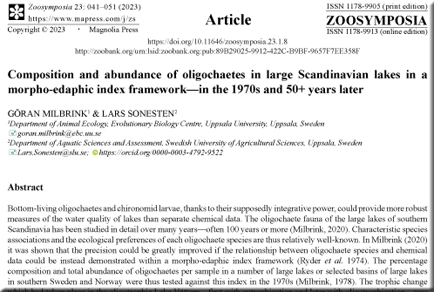Abstract
Bottom-living oligochaetes and chironomid larvae, thanks to their supposedly integrative power, could provide more robust measures of the water quality of lakes than separate chemical data. The oligochaete fauna of the large lakes of southern Scandinavia has been studied in detail over many years—often 100 years or more (Milbrink, 2020). Characteristic species associations and the ecological preferences of each oligochaete species are thus relatively well-known. In Milbrink (2020) it was shown that the precision could be greatly improved if the relationship between oligochaete species and chemical data could be instead demonstrated within a morpho-edaphic index framework (Ryder et al. 1974). The percentage composition and total abundance of oligochaetes per sample in a number of large lakes or selected basins of large lakes in southern Sweden and Norway were thus tested against this index in the 1970s (Milbrink, 1978). The trophic change which had taken place in the oligotrophic Lake Vättern—first with eutrophication and later with oligotrophication—was illustrated graphically and discussed in this work (Milbrink, 2020).
A very similar trophic change could also be seen in the oligotrophic Lake Vänern (the basin of Värmlandssjön), as well as in the more eutrophic Lakes Mälaren and Hjälmaren. All these large lakes, once eutrophied in the 1950s and 1960s, are today undergoing oligotrophication. We simply have a melioration thanks to advanced sewage treatment since the 1960s. With our new knowledge, it is informative studying changes in species composition after trophic change. In a time when efforts to save the environment often fail, this new development is a real success story.
References
Aston, C.J. (1973) Tubificids and water quality: A review. Environmental Pollution, 5 (1), 1–10. https://doi.org/10.1016/0013-9327(73)90050-5
Brinkhurst, R.O. & Kennedy, C.R. (1965) Studies on the biology of the Tubificidae (Annelida, Oligochaeta) in a polluted stream. Journal of Animal Ecology 34 (2), 429–443. https://doi.org/10.2307/2659
Kennedy, C.R. (1965) The distribution and habitat of Limnodrilus Claparède (Oligochaeta: Tubificidae). Oikos, 16 (1/2), 26–38. https://doi.org/10.2307/3564862
Lang, C. (1984) Eutrophication of Lakes Leman and Neuchatel (Switzerland) indicated by oligotrophic communities. Hydrobiologia, 115 (1), 131–138. https://doi.org/10.1007/BF00027907
Lang, C. & Reymond, O. (1996) Reversal of eutrophication in four Swiss lakes: evidence from oligochaete communities. Hydrobiologia, 334 (1–3), 157–161. https://doi.org/10.1007/BF00017365
Liebmann, H. (1962) Handbuch der Frischwasser- und Abwasserbiologie. Band I.R. Oldenbourg, München, 588 pp.
Milbrink, G. (1971). A simplified tube bottom sampler. Oikos 22, 260–263. https://doi.org/10.2307/3543736
Milbrink, G., Pramsten, H. & Lundqvist, S. (1974) On the horizontal distribution of the profundal bottom fauna in a limited area of central Lake Mälaren, Sweden. Hydrobiologia, 45 (4), 509–541. https://doi.org/10.1007/BF00012034
Milbrink, G. (1978) Indicator communities of oligochaetes in Scandinavian lakes. Verhandlungen der Internationale Vereinigung der Limnologie, 20, 2406–2411. https://doi.org/10.1080/03680770.1977.11896887
Milbrink, G. (1980) Oligochaete communities in pollution biology. The European situation with special reference to lakes in Scandinavia. In: Brinkhurst, R.O. & Cook, D.G. (Eds.), Aquatic Oligochaete Biology. Plenum Press, pp. 433–455. https://doi.org/10.1007/978-1-4613-3048-6_22
Milbrink, G. (1983) Characteristic deformities in tubificid oligochaetes inhabiting polluted bays of Lake Vänern, Southern Sweden. Hydrobiologia, 106, 169–184. https://doi.org/10.1007/BF00006749
Milbrink, G. (1999) Distribution and dispersal capacity of the Ponto-Caspian tubificid oligochaete Potamothrix heuscheri (Bretscher, 1900) in Scandinavia. Hydrobiologia, 406, 133–142. https://doi.org/10.1023/A:1003752621110
Milbrink, G. (2020) Composition and abundance of oligochaetes in Scandinavian lakes in the 1970s in full compatibility with the “morpho-edaphic index”. Do these relationships still hold 40 years later? Zoosymposia, 17, 77–88. https://doi.org/10.11646/zoosymposia.17.1.9
Milbrink, G. & Sonesten, L. (2014) Deformiteter hos oligochaeter i Vänern. SLU, Institutionen för vatten och miljö, rapport 2014, 19. [in Swedish]
Milbrink, G. & Wiederholm, T. (1973) Sampling efficiency of four types of mud bottom samplers. Oikos, 24, 479–482. https://doi.org/10.2307/3543828
Ryder, R.A., Kerr, S.R., Loftus, K.H. & Regier, H.A. (1974) The morphoedaphic index, a fish yield estimator review and evaluation. Journal of the Fisheries Research Board of Canada, 31 (5), 663–688. https://doi.org/10.1139/f74-097
Zelinka, M. & Marvan, P. (1961) Zur Präzisierung der biologischen klassifikation der reinheit fliessender Gewässer. Archiev für Hydrobiologie, 57, 1–20.


